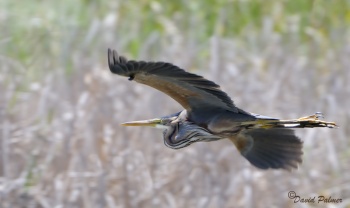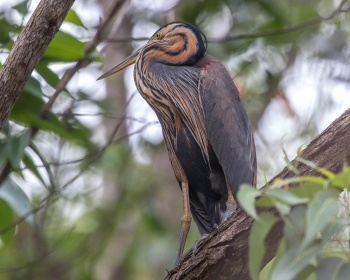- Ardea purpurea
Inlcudes: Cape Verde Purple Heron
Identification
78–90 cm (30¾-35½ in) It is similar to the Grey Heron, but its plumage is a darker reddish-brown and the adults have a darker grey back. It has a narrower yellow bill, which is brighter in breeding adults.
Distribution
A widespread Old World species. Has a patchy breeding range in the Netherlands and parts of Germany, in north and central France, and across southern Europe from Iberia to Greece and Turkey, north to Ukraine and east to the Caspian and Aral Seas. Also breeds in Iraq, and from Pakistan, India and Sri Lanka, throughout South-East Asia, north to the Russian Far east and south to Java and Sulawesi. Breeds at a few sites in North Africa, on the Cape Verde Islands and Senegal and more commonly in Madagascar and East Africa from southern Kenya southwards.
Western Palearctic breeders are mainly migratory and winter throughout sub-Saharan Africa, most other populations are resident although north-east Asian birds may vacate breeding areas in winter. On passage occurs throughout southern Europe and the Middle East.
Rare but regular passage visitor in very small numbers to Britain with about 20 records per year, mainly in southern England although there have been records north to Scotland. Also occurs as a rare migrant to other northern European countries and a vagrant north to Iceland and the Faroes, Norway, Sweden and Finland.
In the Atlantic recorded on the Azores, Madeira and Canary Islands. The nominate race has also occurred as a vagrant in the Cape Verde Islands. Vagrant to Barbados in the Caribbean[2].
Taxonomy
Subspecies
There are three or four subspecies[1]:
- A. p. bournei: Paler than nominate. This race is not regarded as a valid subspecies by some authors but treated as a full species by others. It is, however, extremely rare with only nine nests found in 2002.
- Cape Verde Islands (Santiago)
- A. p. purpurea:
- South West Palearctic to Iran, Africa south of the Sahara and Cape Verde Islands
- A. p. madagascariensis: Darker than nominate
- A. p. manilensis: Paler than the nominate race, with reduced neck stripes
- Southern and eastern Asia, Indonesia and Philippine Islands
Habitat
Shallow freshwaters with abundant vegetation, especially reedbeds, where usually breeds, also in mangroves in some areas. On passage and in winter in more open habitats, even grassland at times.
Behaviour
Breeding
It builds a nest made of sticks.
Diet
It feeds in shallow water, catching fish, frogs or insects on its long, sharp bill. It will often wait motionless for prey, or slowly stalk its victim.
Flight

Its flight is slow and in flight it retracts its neck. This is a characteristic of herons and bitterns; it differentiates them from storks, cranes and spoonbills, which extend their necks.
Vocalisation
The call is a loud croaking krek.
References
- Clements, J. F., T. S. Schulenberg, M. J. Iliff, D. Roberson, T. A. Fredericks, B. L. Sullivan, and C. L. Wood. 2018. The eBird/Clements checklist of birds of the world: v2018. Downloaded from http://www.birds.cornell.edu/clementschecklist/download/
- Handbook of the Birds of the World Alive (retrieved March 2019)
- 51st supplement to the AOU checklist of North American birds
Recommended Citation
- BirdForum Opus contributors. (2025) Purple Heron. In: BirdForum, the forum for wild birds and birding. Retrieved 26 April 2025 from https://www.birdforum.net/opus/Purple_Heron
External Links
GSearch checked for 2020 platform.1







